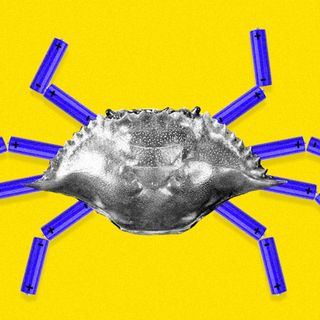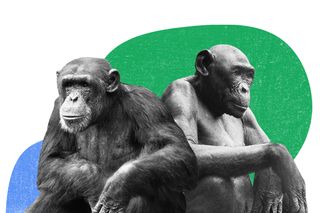
Chimpanzees, Bonobos Became Lonely and Sedentary During the Lockdown, Shows Study
The research paves way to understanding more about “the impact individual differences and animal environments have on animals’ experiences with visitors.”

All primates hunger for sociability: humans, chimpanzees, baboons, bonobos. This desire for interaction was disrupted during the lockdown era of the pandemic, when confinement — both geographical and emotional — became the norm. This led to interesting behavioral patterns among some primates living in the captivity of zoos. Gorillas, for instance, became withdrawn and sedentary. Others, like olive baboons, tended to be more sexually and physically dominant in the way they passed their days.
Loneliness, reclusiveness, fatigue, and changes in libido weren’t just aspects that marked human behavior during an uncharacteristic time in our lives; other animals were impacted too, according to new research published in the journal Animals.
The researchers looked at the species living in a zoo and safari park in the U.K. in 2020, observinghow bonobos, chimpanzees, baboons, and gorillas behaved. Another subsequent analysis followed up on this data, to see how the primates adapted after visitors returned to the zoos when lockdowns ended. The comparison was drawn to gauge if the primates’ lifestyles differed when they lived outside the gaze of visitor interactions.
“Primates are some of the most cognitively advanced species in zoos and their interactions with visitors are complex,” said Samantha Ward, a zoo animal welfare scientist at Nottingham Trent University’s School of Animal, Rural and Environmental Sciences, one of the authors of the study.
It indeed is complex: because the lockdown did not have one singular impact on the population of animal species confined to zoos. Some animals, like the olive baboons, were socially stimulated after the lockdown period and chased more visitor cars. Chimpanzees and baboons had retreated to a more solitary lifestyle in the months of 2020; when the zoo reopened, they were eating more and were found to be more active. Even bonobos and gorillas had abandoned their reclusive habits and weren’t spending a lot of time alone after the lockdown.
But this is not to say that the lockdown-induced solitary behavior is a mark of gloom-ridden despondency, and that the return of visitors to zoos provided an emotional respite to animals. Arguably, bonobos not resting enough is not a good thing, for it is the activity of zoos that picked up that may have disrupted their lifestyles after the lockdown ended. The lockdown may have offered some respite from an otherwise overstimulating environment.
Related on The Swaddle
In a First, a Female Monkey Has Become the Alpha Leader in a Japanese Zoo
The present research echoes still a shift in behaviors among animal species globally. Reports as early as May 2020 reported that zoo animals, otherwise used to visitors, were getting “lonely” and “bored.”
“We have noticed that some of our more ‘social’ animals are not a fan of the stay-at-home and social distancing orders. Primates especially have noticed our guests are gone and go looking for them,” Linda Hardwick, communications director at Phoenix Zoo, told the BBC. In New Zealand, not yet accustomed to the absence of people, rhinos and giraffes were still showing up for their “meet the public” appointments – despite no public.
Arguably, the interaction with people does provide some form of enrichment to some animal species. Which explains why two chimpanzees in zoos in the Czech Republic took favorably upon being exposed to live streaming. In May last year, the staff set up daily Zoom calls for the primates, where they could virtually observe other apes at another zoo for several hours a day. “At the beginning, they approached the screen with defensive or threatening gestures…It has since moved into the mode of, ‘I am in the movies,’” saidzookeeper Gabriela Linhartova. What Linhartova meant is chimpanzees are sitting down and grabbing snacks while getting their viewing of entertainment, just like humans.
Underneath it all was the necessary ways both zookeepers, staff, and the animals themselves had to adapt. In another zoo in the U.K., the staff fed grain to birds and regularly walking around the enclosures to ensure a sense of normalcy in the environment. Another aquarium in Japan had people FaceTiming its eel population so that theydon’t “forget” about humans.
While the lockdown meant more initiative by zookeepers to make sure the animals are engaged, researchers of the present study also observed nifty ways in which the animals themselves adapted their physical environments. Gorillas changed the way they used their enclosures, perhaps as a preemptory action to reduce potential overstimulation by being in the same area.
“Behavioural changes and changes in enclosure use in the presence of visitors highlight the adaptability of zoo species to their environments,” explained Ellen Williams, a zoo animal welfare researcher at Harper Adams University, and another author of the study.
“We recommend that future work seeks to understand the impact individual differences and animal environments have on animals’ experiences with visitors.”
There is a pitfall in every research that claims that animals living in zoos are “lonely” without human interaction. It plays into the same ethically complex argument that zoos are “saving” animals, providing them a shelter, and keeping them engaged. But numerous reports and explorations have revealed the extent of abuse and inadequate habitats in these breeding programs. Wildlife is commodified for people’s entertainment and a local region’seconomic health. The “loneliness” of primates is more morbid in this context: species are removed from their homes and displaced to such an extent that it becomes a moral imperative for these institutions to maintain a connection with human visitors.
British historian Fay Bound Alberti, in “A Biography of Loneliness: The History of an Emotion,” defined lonelinesss to be “a conscious, cognitive feeling of estrangement or social separation from meaningful others.” When meaning is artificially created, emotional connection yearns to find order in chaos. Loneliness then didn’t start with the lockdown — it may have been a socially engineered state of being for some.
Saumya Kalia is an Associate Editor at The Swaddle. Her journalism and writing explore issues of social justice, digital sub-cultures, media ecosystem, literature, and memory as they cut across socio-cultural periods. You can reach her at @Saumya_Kalia.
Related


Pakistan’s Floods Stir Debate on ‘De‑growing’ the Economy To Address Climate Change
